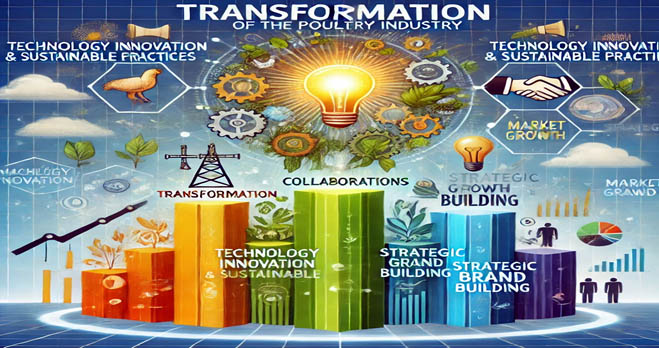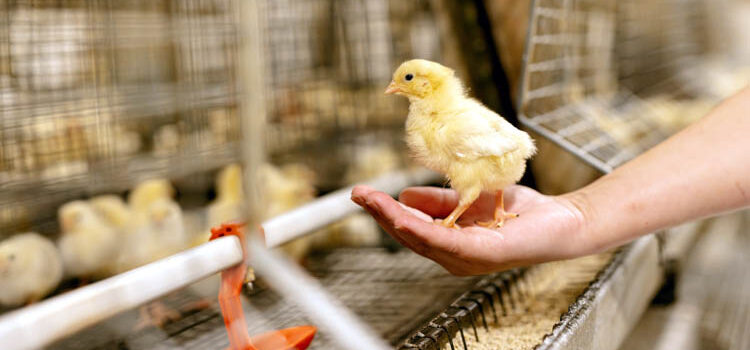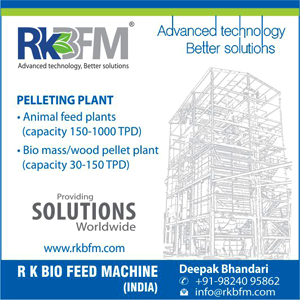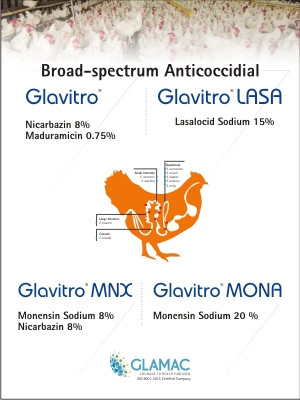An overview of Indian Poultry Sector:
India is one of the world’s largest producers of eggs and poultry meat. The industry has grown rapidly over the past few decades due to increasing domestic demand driven by population growth, rising incomes, and changing dietary preferences. The Indian poultry industry contributes significantly to the agricultural sector, with poultry production growing extensively over the last few decades.

Serial Entrepreneur, Researcher & Strategic Consultant
dranjangoswami@gmail.com
Mobile No: +919449871819
The livestock sector, which includes poultry, has witnessed a compound annual growth rate (CAGR) of 7.9% from 2014-15 to 2020-21, and its share in the total agriculture Gross Value Added (GVA) increased from 24.3% to 30.1% during the same period. In financial terms, the revenue of the Indian poultry industry surged over 30% to approximately ₹2,500 billion (US$ 31.4 billion) in FY 2022-23, reflecting strong demand and capacity utilization. These figures highlight the critical role the poultry industry plays in the broader agricultural economy, contributing to both GVA and overall economic activity in India.(Courtesy: India Brand Equity Foundation).
Impact on the Economy:
The poultry sector not only contributes significantly to India’s GDP but also provides employment to millions of people directly and indirectly. It plays a crucial role in ensuring food security and nutritional support through the provision of high-quality protein at an affordable cost. While the Indian poultry industry has made impressive strides, tapping into its full potential requires addressing existing challenges through innovative solutions, improved infrastructure, and supportive policies.
Transformation: Indian Poultry 2.0

Indian Poultry 2.0 represents a significant transformation of India’s poultry sector, driven by technological advancements, changing consumer preferences, and evolving market dynamics. The shift is characterized by modernization, sustainability, and efficiency to meet both domestic and global demands.
A bird eye view on Future of Indian Poultry
- Technological Advancements
- Smart Farming Techniques: The integration of technology such as IoT (Internet of Things) sensors, AI-driven analytics, and automated feeding systems streamlining farm management, ensuring better health monitoring, optimized feed usage, and improved yield.
- Precision Farming: Technologies like drones and data analytics enabling farmers to monitor flock health, temperature control, and feed consumption in real-time, allowing for early interventions and better resource management.
- Sustainability and Eco-Friendly Practices
- Waste Management: Poultry farms are increasingly adopting sustainable waste management practices, such as converting poultry waste into biogas and organic fertilizers, reducing environmental impact and creating additional revenue streams.
- Sustainable Feed Practices: Shift towards eco-friendly and cost-effective feed alternatives, including soy substitutes, insect-based protein, and locally sourced feed ingredients, reduces dependency on expensive imports and promotes sustainability.
- Focus on Animal Welfare
- Improved Living Conditions: Poultry farms are increasingly adopting humane treatment practices, ensuring larger living spaces, better ventilation, and natural growth cycles. This not only aligns with ethical standards but also improves meat quality.
- Antibiotic-Free Poultry: With rising consumer awareness around health and food safety, there’s a growing focus on producing antibiotic-free and hormone-free poultry, catering to the health-conscious market.
- Value-Added Products
- Product Diversification: Indian Poultry 2.0 is seeing an increased focus on value-added products such as ready-to-cook and pre-marinated poultry items. This caters to urban consumers seeking convenience and variety in their meals.
- Organic and Free-Range Poultry: The rise of organic and free-range poultry products caters to a niche yet growing market segment concerned about health and ethical farming.
- Digital Integration
- E-Commerce and Direct-to-Consumer Sales: Poultry producers are leveraging digital platforms and e-commerce to directly reach consumers, cutting out intermediaries and increasing profitability. Apps and online platforms offer fresh, traceable poultry products at consumers’ doorsteps.
- Blockchain for Traceability: Transparency in the supply chain is becoming critical. Blockchain technology is enabling consumers to trace the journey of poultry products from farm to table, increasing trust and brand value.
- Expansion of Organized Farming
- Integration of Small Farmers: Large organized poultry farms are increasingly collaborating with small and medium-sized farmers through contract farming, enabling better access to resources, technology, and markets while providing assured income for farmers.
- Cluster-Based Financing: Financial institutions are promoting cluster-based financing models, allowing poultry farmers to access loans and credit, fostering infrastructure development, and encouraging growth.
- Health and Nutrition Focus
- Boosting Protein Consumption: The poultry sector plays a critical role in meeting the protein needs of a growing population. Indian Poultry 2.0 is focused on promoting affordable, high-quality poultry products to improve nutrition across the country.
- Functional Poultry Products: Poultry producers are experimenting with fortified eggs and chicken enriched with omega-3 fatty acids and vitamins to cater to the health-conscious segment.
- Enhanced Biosecurity Measures
- Disease Prevention: Indian Poultry 2.0 emphasizes stringent biosecurity protocols to prevent outbreaks of avian influenza and other diseases, using vaccination programs, isolation of infected birds, and disinfecting tools to reduce risks.
- Improved Veterinary Services: Collaborations with veterinary experts and technology-based health monitoring tools ensure that poultry health issues are addressed promptly.
- Government Initiatives and Policy Support
- Policy Reforms: Government support through the National Livestock Mission and other initiatives focuses on improving infrastructure, boosting exports, and making poultry farming more profitable.
- Subsidies and Incentives: Subsidies for technological adoption, waste management, and sustainable practices are encouraging farmers to modernize their operations and increase efficiency.
- Global Market Integration
- Increased Exports: With better compliance with global standards and traceability, Indian poultry products are gaining traction in international markets, particularly in the Middle East and Southeast Asia.
- Trade Partnerships: Strategic partnerships with global players and multinational companies are enhancing India’s presence in the global poultry market, opening up new avenues for growth.
Converting Competition to collaboration: “Coopetition”

The shift from competition to collaboration, often referred to as “coopetition,” is a strategic transformation that can drive innovation, expand markets, and enhance efficiencies across the verticals within the poultry sector. Here are key elements that facilitate this transformation:
- Shared Goals and Objectives:
Organizations with the sector identify mutual benefits that outweigh the advantages of working in isolation. By aligning goals, companies can leverage each other’s strengths to tackle bigger challenges or create larger market opportunities. - Trust and Transparency
Successful collaboration requires a foundation of trust. This means open communication, sharing of relevant information, and transparency about capabilities and intentions. Trust ensures that all parties feel secure in sharing resources and knowledge. - Complementary Strengths
Collaboration works best when each party brings unique skills or resources that complement those of others. This can be technological expertise, market access, or manufacturing capacity, allowing each participant to benefit from the strengths of others without duplicating efforts. - Governance and Structure
Clear agreements on the framework of collaboration are crucial. This includes understanding roles, responsibilities, and contributions of each party. Structured governance mechanisms help manage the partnership effectively and resolve conflicts. - Legal and Ethical Considerations
Formal agreements that outline the legal boundaries and ethical standards of the collaboration are important to protect intellectual property, ensure compliance with regulations, and define profit-sharing structures. - Technology and Tools
Investment in compatible technology and collaborative tools can enhance interaction, improve data sharing, and streamline operations across different platforms.
This strategic shift is often facilitated by external pressures such as market saturation, technological disruptions, or regulatory changes, which make collaboration more appealing or necessary. As industries and markets evolve, the ability to move from competition to collaboration can provide a significant competitive edge and drive sustainable success.
Strategic Brand Building:
Strategic brand building in the poultry sector is about establishing trust, differentiating products, and ensuring that a brand aligns with consumer values like quality, sustainability, and ethical practices. By focusing on these areas, poultry businesses can develop a strong brand that fosters customer loyalty and long-term growth.

Here’s a structured approach to building a strong brand in the poultry industry:
- Defining Brand Identity
- Core Values: Clearly define mission, vision, and values that guide a poultry business. For example, focussing on high-quality, ethically raised poultry or sustainable farming practices.
- Brand Personality: Develop a brand personality that resonates with your target audience. This could be one of trustworthiness, innovation, or community engagement.
- Understanding the Target Audience: Segmentation
- Conduct market research to understand customers’ preferences, concerns, and behaviours regarding poultry products (e.g., organic, antibiotic-free, free-range).
- Segment the market to tailor your message (households, restaurants, retailers, etc.)
- Product Differentiation: Positioning
- Quality Assurance: Establish a reputation for high-quality, safe, and nutritious poultry products. Implement certifications like organic or antibiotic-free to distinguish your products.
- Innovation: Introduce value-added products like pre-cooked, marinated, or convenience-packaged poultry to appeal to modern consumers seeking easy-to-prepare meals.
- Sustainability and Ethical Practices: Highlight sustainable farming methods, waste reduction, and ethical animal treatment practices. Consumers are increasingly concerned about sustainability, making this a key differentiator.
- Build Trust through Transparency: Create trust by being transparent about your production processes. Show customers how your poultry is raised, processed, and delivered. Use packaging and marketing materials to tell this story.
- Marketing and Brand Communication: Targeting
- Consistent Messaging: Ensure consistent branding and messaging across all channels—packaging, advertising, social media, website, and customer service. Focus on quality, sustainability, and trust.
- Digital Presence: Utilize social media, blogs, and online platforms to share information about your products, engage with customers, and showcase your brand values.
- Partnerships: Collaborate with restaurants, supermarkets, and other food brands to expand your brand reach and establish credibility.
- Leverage Technology and Innovation
- Traceability: Incorporate blockchain or tracking technology to allow customers to trace the origins of your poultry products, ensuring transparency and boosting trust.
- Smart Farming: Highlight your use of modern farming technologies like automation, AI-based monitoring, and precision feeding to assure consumers of your efficiency and quality control.
- Customer Experience and Feedback
- Ensure excellent customer service at every touchpoint, from purchasing to post-sales support.
- Actively seek and use customer feedback to improve products and services, showing you care about their needs and satisfaction.
- Strategic Partnerships
- Form strategic partnerships with suppliers, retailers, or eco-friendly organizations to boost your brand’s credibility and access new markets.
- Monitoring and Adaptation
- Continuously monitor market trends, consumer behaviour, and competitors. Adapt the brand strategy to meet changing demands, such as the growing trend for plant-based protein alternatives.
Summary:
Indian Poultry 2.0 marks a pivotal evolution from traditional farming to a more efficient, sustainable, and technology-driven industry. By embracing modern farming practices, enhancing biosecurity, and aligning with global standards, the Indian poultry sector is poised to meet both the growing domestic demand and expand its footprint in global markets. This transformation will not only boost productivity and profitability but also contribute significantly to rural development and national food security.
About the author: https://www.poultrytrends.in/dr-anjan-goswami






